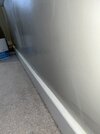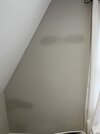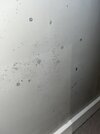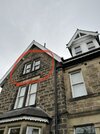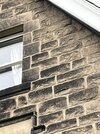A friend of ours lives in a top floor flat in a stone-built Victorian semi-detached house, and has what appears to be condensation problems on just one wall in a bedroom. Main points as follows:
The flats were converted about 20 years ago, and it looks to have been done well and to high standard as far as it's possible to tell from the finish.
The rest of flat seems fine.
The problems only occur during winter when it's very cold, suggesting this isn't penetrating damp from a leak. The pointing looks OK as far as it's possible to tell from ground level photos.
The problem seems to be at its worst below the window level, but some patches higher up.
The wall faces East so ought to get some sun. The mirror image flat in the other half of the semi is fine.
In spite of keeping the room well aired, and even using a dehumidifier, moisture can apparently form on the wall relatively quickly - say a couple of hours.
The previous occupants reckon not to have had any problems.
That wall has been painted since the previous occupants had it, which makes us wonder whether it had breathable emulsion on it before, so perhaps the problem WAS there but moisture didn't sit on the surface to the same degree.
We don't know yet what sort of plaster, insulation etc. would/should have been used.
The working assumption is the surface of the plaster inside is way colder than it should be for some reason on that particular wall such that the heating being on is making little difference to the surface temperature - such as a gap somewhere in the structure allowing cold air to get behind, or missing some insulation that is present elsewhere in the flat. Any thoughts/experiences/fixes appreciated. Thanks!
The flats were converted about 20 years ago, and it looks to have been done well and to high standard as far as it's possible to tell from the finish.
The rest of flat seems fine.
The problems only occur during winter when it's very cold, suggesting this isn't penetrating damp from a leak. The pointing looks OK as far as it's possible to tell from ground level photos.
The problem seems to be at its worst below the window level, but some patches higher up.
The wall faces East so ought to get some sun. The mirror image flat in the other half of the semi is fine.
In spite of keeping the room well aired, and even using a dehumidifier, moisture can apparently form on the wall relatively quickly - say a couple of hours.
The previous occupants reckon not to have had any problems.
That wall has been painted since the previous occupants had it, which makes us wonder whether it had breathable emulsion on it before, so perhaps the problem WAS there but moisture didn't sit on the surface to the same degree.
We don't know yet what sort of plaster, insulation etc. would/should have been used.
The working assumption is the surface of the plaster inside is way colder than it should be for some reason on that particular wall such that the heating being on is making little difference to the surface temperature - such as a gap somewhere in the structure allowing cold air to get behind, or missing some insulation that is present elsewhere in the flat. Any thoughts/experiences/fixes appreciated. Thanks!


